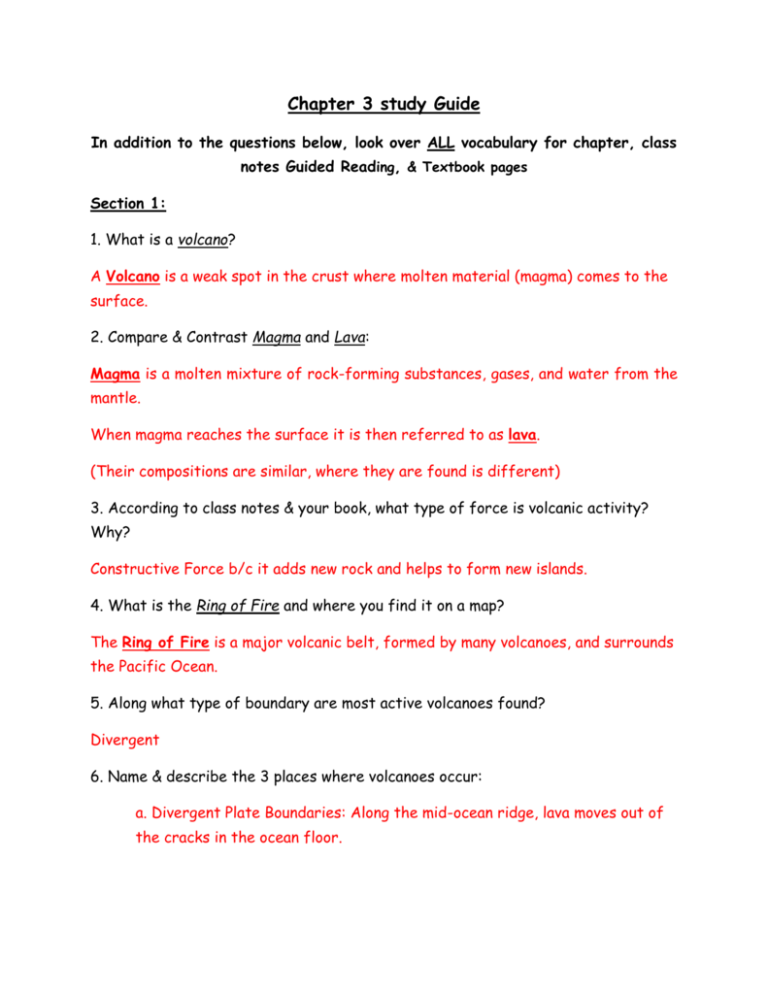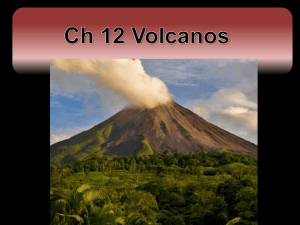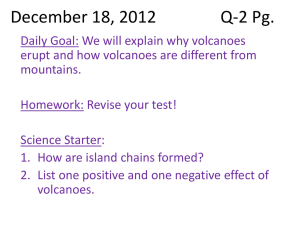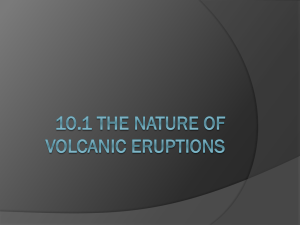Study Guide Answers - West Branch Schools
advertisement

Chapter 3 study Guide In addition to the questions below, look over ALL vocabulary for chapter, class notes Guided Reading, & Textbook pages Section 1: 1. What is a volcano? A Volcano is a weak spot in the crust where molten material (magma) comes to the surface. 2. Compare & Contrast Magma and Lava: Magma is a molten mixture of rock-forming substances, gases, and water from the mantle. When magma reaches the surface it is then referred to as lava. (Their compositions are similar, where they are found is different) 3. According to class notes & your book, what type of force is volcanic activity? Why? Constructive Force b/c it adds new rock and helps to form new islands. 4. What is the Ring of Fire and where you find it on a map? The Ring of Fire is a major volcanic belt, formed by many volcanoes, and surrounds the Pacific Ocean. 5. Along what type of boundary are most active volcanoes found? Divergent 6. Name & describe the 3 places where volcanoes occur: a. Divergent Plate Boundaries: Along the mid-ocean ridge, lava moves out of the cracks in the ocean floor. b. Convergent Plate Boundaries: Volcanoes occur where subduction takes place• Oceanic crust sinks through a trench and back into the mantle. This crust melts, forming magma which eventually rises to the Earth’s surface. • When the magma erupts as lava, volcanoes are formed. c. Hot Spots: A hot spot is an area where magma from deep within the mantle melts through the crust like a blow torch resulting in the formation of a volcano Usually found in the middle of oceanic or continental plates, away from plate boundaries 7. What is an Island Arc & what are the names of at least 3 major Island Arcs • An Island Arc is a string of islands formed by the volcanoes along a deep ocean trench. • Japan, New Zealand, Indonesia, Caribbean Islands, Philippines, Aleutians 8. What is a Hot Spot & be able to describe how this helped to form the Hawaiian Islands: A hot spot is an area where magma from deep within the mantle melts through the crust like a blow torch. The Hawaiian Islands formed as the Pacific Plate drifted over a hot spot. Section 2: 1. Where does magma form? (Be specific) Asthenosphere of the Mantle 2. As magma rises what are its two options? It continues until it reaches Earth’s surface OR is trapped beneath layers of rock. It trapped beneath layers of rock. 3. Why does magma rise? • Liquid magma flows upward because it is less dense than the surrounding solid material. 4. Describe in great detail about how a volcano erupts & how it is similar to how a pop bottle explodes: • Lava begins as magma in the mantle and flows upward towards the Earth Surface because of its density. As it rises pressure decreases and gasses spread out to form bubbles. The volcano erupts when an opening is created in weak rocks of the Earth’s surface and gases that were once dissolved in the magma rush out carrying the magma with them. 5. How quickly magma flows is dependent on its temperature. 6. What is Silica and what impact does silica have on magma that is high or low in silica content (include the type of rock that can be formed by these types & the explosiveness of a volcano)? • Silica is a material that is formed from the elements oxygen and silicon. -High: Magma high in silica cools as the light colored rock rhyolite, pumice and obsidian. - Volcanoes erupt violently -Low: Magma low in silica cools as the dark colored rock basalt - Volcanoes erupt quietly 7. What is the difference between the 2 types of lava, formed by quiet eruptions? – Pahoehoe: Fast-moving, hot lava – aa: Slower-moving, cooler lava 8. During an explosive eruption, lava is broken up into 3 different size fragments; list & describe the differences among them: – Smallest: Volcanic ash (Fine, rocky particles) – Cinders (pebble sized particles) – Largest: Bombs (Range from size of baseball to the size of a car!) 9. Name & describe the 3 stages of life for a volcano. How do these mirror the life stages of a human? • An Active volcano or “live” volcano is one that is erupting or shows signs of erupting in the near future. • A dormant volcano or “sleeping” volcano can awaken in the future and become active. 1000’s of years can pass between eruptions • An extinct volcano or “dead” volcano is unlikely to ever erupt again. 10. Name & describe 2 types of volcanic activity that DOES NOT involve the erupting of lava: a. A hot spring forms when ground water is heated by a nearby body of magma and rises to the surface and is collected in a natural pond. • b. A geyser is a fountain of water and steam that erupts from the ground. 11. What is a type of energy that can be used as a cause of volcanic activity? Why is this a GOOD source of energy? Geothermal Energy is a clean, reliable energy source that is created by the heating of water in volcanic areas by magma. 12. Be able to label & describe the parts of a volcano (class handout or page 95 in book) See Text book / notes 13. What are the 3 factors that influence a volcanic eruption? 1. The amount of gas dissolved in the magma 2. Its temperature 3. Silica content 14. How can scientists measure the likelihood of a volcano erupting: Monitor gases leaving a volcano, temperature of underground water (is it getting hotter?) 15. What are some effects of a volcano erupting on a town? (Name at least 3) – Bury and set fire to everything in its path – Release volcanic gases, cinders & bombs. – Ash can bury entire towns, damage crops & clog car engines – If wet, can collapse roofs – Landslides and avalanches of mud, melted snow & rock Section 3: 1. Name & Describe 4 landforms that are created from lava & Ash (and how they are formed): a. Shield Volcanoes are formed when thin layers of lava pour out a vent, and hardens on previous layers. Forms a wide, gentle sloped mountain. Occurs during quiet eruptions b. Cinder Cone Volcanoes are formed when cinders erupt explosively from a volcano's vent, they pile up around the vent and form a steep, cone-shaped hill. c. Composite volcanoes are formed when layers of lava alternate with layers of ash, cinder and bombs. They are tall, cone-shaped mountains also called Strato Volcanoes d. Lava Plateaus are created by lava eruptions instead of mountains. Formed when lava flows out of cracks in a specific area. This thin lava can travel long distances before cooling and hardening. After repeating this process for millions of years, this lava eventually forms high plateaus. 2. What is a Caldera any why does this form in a volcano? Caldera is the hole left by the collapse of a volcanic mountain. When the main vent and magma chamber of a volcano is emptied, due to large eruptions, the mountain becomes hollow. Nothing remains to support it so the top of the mountain collapses inward. 3. How does volcanic activity result in the formation of soil? Is this process called primary or secondary succession & why? (Think back to 7th grade science!) • Over time, lava that has once hardened to rock, will break down to form soil. • Primary Succession, because the soil is being created in order for new life to be formed (it is not there already) 4. Name & Describe 5 landforms that are created when magma DOES NOT reach the Earth’s surface (include diagrams where applicable): a. A Volcanic Neck forms when magma hardens in a volcano’s pipe. – The soft rock surrounding the pipe wears away exposing the hardened rock. b. Magma that forces itself across rock layers hardens into a dike. c. When magma squeezes between layers of rock it forms a sill. d. A batholith is a mass of rock formed when a large body of magma cools inside the crust. e. Dome Mountains - Formed when rising magma is blocked by horizontal layers of rock. The magma forces the layers of rock to bend upward into a dome shape Section 4: 1. Look over guided reading for this section. No notes were given on this section.







